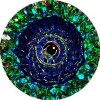[attachment=1303:widget_screenshot.png]
Example of my mob spawner controller. Note the sliders, buttons and labels are nicely (and automatically) arranged. I apologize that the screen shot is too small. I uploaded a larger image, and I'm not sure how to make it larger on the forum. If anyone has advice, I'd be happy to hear it.
Documentation:
[attachment=1305:widget_doc.pdf]
1 Features
• ease of use; few and simple commands to create and customize widgets
• automatic positioning of widgets means less work and better looking widgets; They also look good on different screen sizes
• myriad of widget types:
– buttons
– sliders
– toggles
– chooser (think drop-down combo box)
– labels
– progress bars
– and more
• object oriented framework makes adding new widgets easy; typically 10-15
minutes for me
• documentation and quick-start guide
2 Installation
Download widget from http://pastebin.com/PSmSpaLk . Place file in either rom/apis or your directly to your ComputerCraft computer.
Alternatively if you're running Minecraft v1.6 you can download and install the resource pack
[attachment=1306:widget.zip]
At least I think so. I'm running 1.5 myself so I haven't been able to test resource packs.
Load with the command
os.loadAPI("widget")3 Quick Start
Spoiler
The first step to creating a GUI is to load the widget library with the code
os.loadAPI("widget")
exampleButton=widget.newButton("press me")
exampleSlider=widget.newSlider(1,10)
quitButton=widget.newButton("quit")
exampleColumn=widget.newColumn()
exampleColumn:add(exampleButton)
exampleColumn:add(exampleSlider)
exampleColumn:add(quitButton)The column will now give its space to the widgets you’ve added. In this case it will split the space evenly (or as evenly as possible) between the two buttons and the slider. Its important to note that rows and columns are widgets too. That means you can have rows of columns or columns of rows. My mob spawner controller has a column of rows with columns in it.
Next, we should tell the computer what to do when the button is pressed. For example, if we wanted to print the value of the slider, then we would use the code
function exampleButton.onClick(button)
exampleButton:blink()
print("The slider has a value of " .. tostring(exampleSlider.value))
end
function quitButton.onClick(button)
exampleColumn.run=false
end
exampleColumn:run()4 Configuring the API
Spoiler
For the most part no configuration is necessary.4.1 Changing the color scheme
If you want to change the color scheme, set the following variables:
- widget.defaultButtonBackground
- widget.defaultButtonForeground
- widget.terminalBackground
- widget.defaultSliderForeground
- widget.defaultSliderBackground
- widget.defaultFlagMonitorForeground
- widget.defaultProgressBarForeground
Normally the attached advanced monitor is automatically detected. However, there are two situations in which you would want to set the monitor manually. The first is if there are more than one advanced monitors adjacent to your computer and it is autodetecting the wrong one. In that case, use something like
widget.setMonitor(peripheral.wrap("bottom"))
widget.setMonitor(term)5 widget API for GUI designers
Spoiler
5.1 widgetConstructor:
example=widget.newWidget()Functions and Fields:
example:run()example:onClick()example:draw()example:processEvent(event,side,x,y)example.vWeightexample.hWeight5.2 row
Constructor:
example=widget.newRow()example:add(widget)example.hSpacingWeight5.3 column
Constructor:
example=widget.newColumn()example:add(widget)example.vSpacingWeight5.4 button
Constructor:
example=widget.newButton(”label”)Functions and Fields:
example:drawFull()example:drawOutline()example:blink()example.label5.5 toggle button
Constructor:
example=newToggleButton(”label”)Functions and Fields:
example:toggle()example.state5.6 label
Constructor:
example=widget.newLabel(”text”)example.text5.7 slider
Constructor:
example=widget.newSlider(1,10)Functions and Fields:
example.valueexample.foregroundColor example.backgroundColor5.8 flag monitor
Constructor:
example=widget.newFlagMonitor(”top”)Functions and Fields:
example:get(i)example:set(i,value)example:clear(i)example:toggle(i)example.flags5.9 chooser
Constructor:
example=widget.newChooser(”axe”,”pick”,”axe”,”fish”)Functions and Fields:
example:chooseexample.label5.10 progress bar
Constructor:
example=newProgressBar(15)Functions and Fields:
example.valueexample.foregroundexample.background6 Possible future features
• a variable widget which can change between different widget types
• a tab widget which switches between multiple interface pages
• multimonitor support
• documentation for adding new widgets
7 example application: keypad
Spoiler
redstone.setOutput("right",false) -- lock the door
os.loadAPI("widget")
-- a button to operate a lock via a keypad advanced monitor
-- which means no control-t or control-r override
-- create the widgets
button1=widget.newButton("1")
button2=widget.newButton("2")
button3=widget.newButton("3")
button4=widget.newButton("4")
button5=widget.newButton("5")
button6=widget.newButton("6")
button7=widget.newButton("7")
button8=widget.newButton("8")
button9=widget.newButton("9")
button0=widget.newButton("0")
backspaceButton=widget.newButton("<-")
clearButton=widget.newButton("reset")
-- arrange the widgets
row1=widget.newRow()
row1:add(button7)
row1:add(button8)
row1:add(button9)
row2=widget.newRow()
row2:add(button4)
row2:add(button5)
row2:add(button6)
row3=widget.newRow()
row3:add(button1)
row3:add(button2)
row3:add(button3)
row4=widget.newRow()
row4:add(backspaceButton)
row4:add(button0)
row4:add(clearButton)
main=widget.newColumn()
main:add(row1)
main:add(row2)
main:add(row3)
main:add(row4)
-- program variables
passcode="1337"
entry=""
-- configure the widgets
function clearButton.onClick(button)
entry=""
end
function backspaceButton.onClick(button)
if (entry:len()>0) then
entry=entry:sub(1,entry:len()-1)
end
end
function button0.onClick(button)
entry=entry .. button.label
if (entry==passcode) then
print("access granted " .. os.time())
redstone.setOutput("right",true) -- open the door
os.sleep(4) -- let someone through
redstone.setOutput("right",false) -- automatically lock the door a
entry=""
end
end
-- all the buttons should do the same thing
-- append their label to entry
-- and check if the code is entered
-- so we can just copy the onClick function
-- instead of rewriting it
button1.onClick=button0.onClick
button2.onClick=button0.onClick
button3.onClick=button0.onClick
button4.onClick=button0.onClick
button5.onClick=button0.onClick
button6.onClick=button0.onClick
button7.onClick=button0.onClick
button8.onClick=button0.onClick
button9.onClick=button0.onClick
-- display the GUI
main:run()8 Licensing







